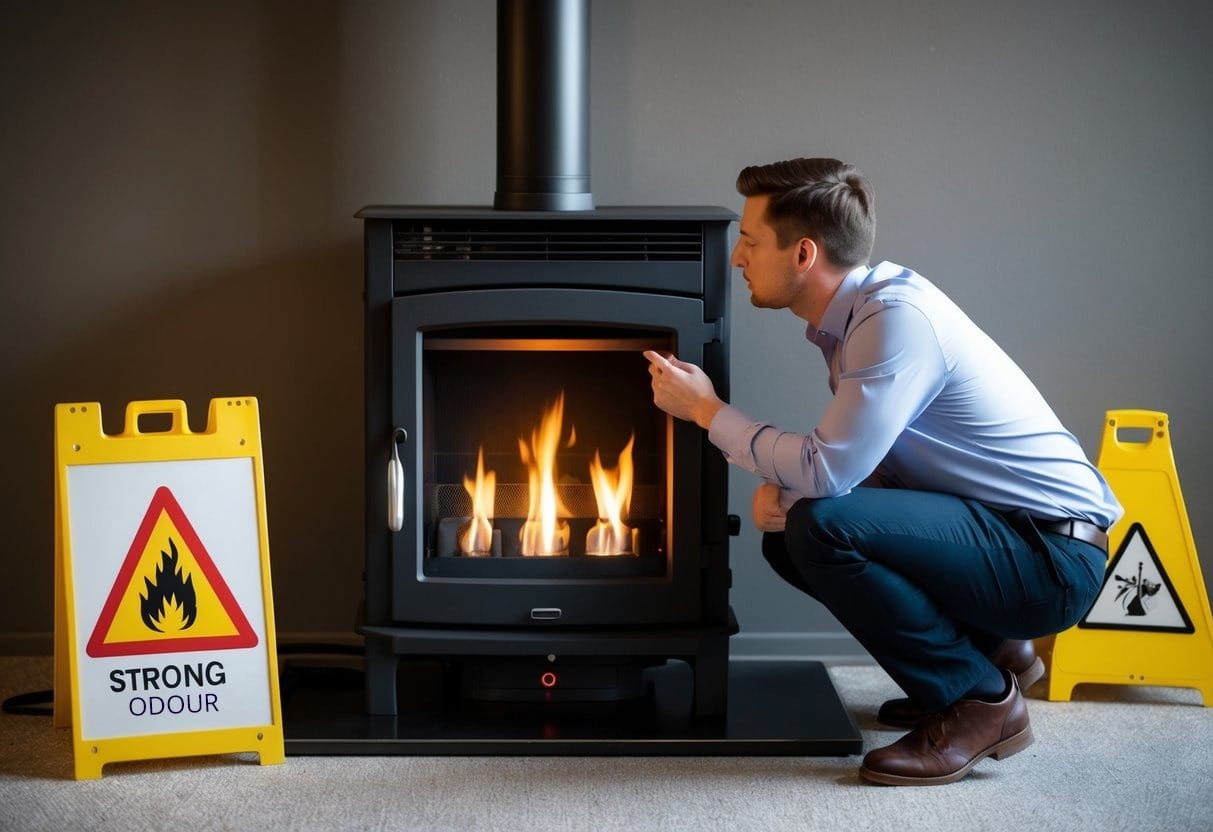
Why Gas Fireplace Smells: Common Causes Explained
For homeowners enjoying the inviting warmth of a gas fireplace, an unexpected odor can be unsettling. Recognizing the cause of these smells is crucial not only for comfort but also for safety. A persistent gas smell can indicate a leak that requires immediate professional attention.
Though some odors are natural and temporary, like the initial burning of dust after a long period of inactivity, others can suggest maintenance issues. A fireplace might emit a burning dust odor during the first seasonal use due to accumulated dust or pet hair. Chemical smells may arise from manufacturing residues in new installations, and a more unpleasant odor might point to a blockage, creating a space for critters or debris.
Understanding the diverse causes and ensuring proper maintenance can help mitigate potential hazards or discomfort. Regular cleaning and inspection of the gas line, flue, and seals are essential to prevent ongoing issues and ensure the appliance’s optimal safety and performance.
Key Takeaways
- Persistent gas smells may signal a leak and require urgent attention.
- Regular maintenance avoids odors caused by dust or debris.
- Understanding fireplace smells boosts air quality and safety.
Understanding Gas Fireplace Smells
Gas fireplaces provide warmth and ambiance but sometimes produce unusual smells. These odors can range from chemical scents to more concerning sulfur-like or burning smells, each indicating different underlying issues.
Identifying Common Odors
Various odors can emanate from a gas fireplace, each with its own implications. A rotten eggs smell often indicates a natural gas leak, as gas companies add a sulfur-like odor for safety. It’s crucial to address this immediately to avoid dangerous situations.
A smell of burning plastic may occur when accumulated dust or pet hair is ignited, especially at the start of a season. If the gas fireplace smells musty, it might involve moisture-related issues or mold growth. Recognizing these scents can help identify necessary actions like cleaning or inspecting the fireplace.
Chemical and Combustion Processes
Some odors result from chemical and combustion processes occurring within the fireplace. New gas installations might produce odors from manufacturing chemicals burning off, creating a temporary chemical smell. Over time, these should dissipate as the fireplace is used.
Combustion can also produce certain odors. Incomplete combustion in particular can lead to various byproducts that may be detected as unpleasant smells. Ensuring the fireplace has proper ventilation and regular maintenance helps prevent these issues. Monitoring how the fireplace smells during operation can provide valuable information on its condition and safety.
Maintenance and Troubleshooting
Ensuring a gas fireplace operates safely involves regular maintenance and being alert to issues like gas leaks or pilot light problems. Proper upkeep helps prevent unpleasant odors and enhances overall efficiency.
Regular Fireplace Maintenance
Routine maintenance is crucial for the safe operation of a gas fireplace. Cleaning the unit prevents the accumulation of dust and debris, which can cause odors or interfere with performance.
It is important to inspect and clean the burner, logs, and glass front regularly. A wire brush can help remove soot that builds up over time. Another maintenance task is to check the ventilation system for blockages to ensure that combustion by-products are properly vented outdoors.
Professional servicing is advised annually to check for any wear and tear or potential issues that might not be visible to the untrained eye.
Detecting and Addressing Gas Leaks
Gas leaks pose significant safety risks and should be addressed promptly. A sulfur or rotten egg smell often indicates a gas leak. This odor is added to natural gas as a safety measure.
If a leak is suspected, turn off the gas supply and ventilate the area immediately. Evacuate the space and contact a professional for inspection and repair. Do not attempt repairs unless properly qualified, as this requires specialized expertise.
Gas detectors can also be installed near the fireplace for continuous monitoring. These devices provide an added layer of safety by sounding an alarm if a leak is detected.
Pilot Light Issues and Solutions
The pilot light plays a crucial role in igniting the gas in a fireplace. If the pilot light goes out, it can cause the fireplace not to function correctly.
A common issue is a draft extinguishing the flame, while clogged components can also be to blame. Ensure that the pilot light area is clean and free of dust. Relighting the pilot can often solve these issues, provided instructions are followed carefully.
If problems persist, checking the thermocouple, which ensures the pilot light remains lit, is essential. A faulty thermocouple may need replacement. For persistent issues, contacting a technician is recommended to diagnose and fix any underlying problems.
Safety Precautions
Ensuring a safe environment when using a gas fireplace is crucial. Key safety precautions include the installation of carbon monoxide detectors and maintaining proper ventilation to minimize risks.
Importance of Carbon Monoxide Detectors
Carbon monoxide is a silent, odorless gas that is potentially deadly. Installing carbon monoxide detectors near the fireplace and in sleeping areas is vital. These devices alert homeowners to unsafe levels of carbon monoxide, giving them time to evacuate and call a professional if necessary.
Regular testing and maintenance of these detectors ensure they function properly. Many experts recommend replacing the batteries twice a year. Choosing a detector with a digital display can offer additional peace of mind by showing current carbon monoxide levels. For optimal safety, it is advisable to connect detectors to a monitored security system if available.
Ventilation and Air Purification
Proper ventilation is essential to safely dissipate gases from a fireplace. Ensuring that vents and chimneys are clear and open is a basic yet critical step. Professional inspections can identify and resolve potential blockages, preventing dangerous build-ups.
Adding an air purifier can help improve indoor air quality, especially one equipped with a HEPA filter capable of capturing small particles. Use of these devices does not eliminate the need for regular airflow but can reduce allergens and improve air quality.
In case of strong odors or unusual fireplace behavior, turning off the system and consulting with a professional is advisable. This proactive approach helps maintain a safe living environment while enjoying the warmth and ambiance of a gas fireplace.
Types of Gas Fireplaces and Their Odors
Gas fireplaces provide efficient heating with distinct characteristics that may contribute to the presence of various odors. Understanding these nuances can help in identifying and addressing specific smells that may arise from your fireplace setup.
Ventless Gas Fireplaces
Ventless gas fireplaces are designed without a chimney or flue and generate heat by burning natural gas or propane directly. Due to their design, any combustion byproducts are released into the room. This can sometimes lead to noticeable odors, such as a rotten egg smell, indicating a gas leak.
It’s essential to maintain proper ventilation to handle emissions like carbon monoxide and water vapor. Regular professional inspections are recommended to ensure safe and efficient operation.
Comparison with Wood-Burning Fireplaces
Gas fireplaces, including both vented and ventless models, typically produce fewer odors compared to wood-burning fireplaces. Wood-burning fireplaces often emit a smoky smell due to incomplete combustion of wood, which is less common in gas fireplaces.
Nevertheless, gas fireplaces can emit odors such as burning dust when first used after a long period or when newly installed. Unlike wood fireplaces, gas units do not leave behind soot or ash, but they still require regular maintenance.
New Gas Fireplace Considerations
New gas fireplaces may emit specific smells during initial use. This occurs as the unit burns off residual manufacturing chemicals or accumulated dust, which might be perceived as a burning plastic smell. This smell usually dissipates after a few uses.
For new installations, ensure proper ventilation and consult with a professional installer if unusual odors persist. Regular maintenance and cleaning can help minimize these initial smells and maintain optimal performance throughout the life of the fireplace.
Professional Assessment and Intervention
Addressing unusual odors in a gas fireplace often requires expert evaluation to ensure safety and proper functioning. These issues may originate from a gas leak, the smell of burning dust, or a burning plastic odor, typically requiring specialized attention.
When to Call a Professional
It is crucial to contact a professional when there is a persistent smell of rotten eggs, commonly indicative of a gas leak involving natural gas or propane. This requires immediate intervention to prevent potential dangers.
Another reason to consult an expert is if the fireplace releases a burning plastic odor, often linked to chemicals newly burned off in some gas fireplaces. Additionally, if burning dust smells persist beyond the fireplace’s initial use, expert cleaning might be needed. Always prioritize safety and proper inspection.
Frequently Asked Questions
Gas fireplaces may sometimes emit strange odors that can be both concerning and unpleasant. Understanding the reasons behind these smells is essential to ensure safety and comfort in the home.
What causes a gas fireplace to emit a rotten egg odor?
A rotten egg odor typically indicates a gas leak. Utility companies add a sulfur-like smell to natural gas and propane, which are otherwise odorless, to help detect leaks easily. If this smell is persistent, it is crucial to switch off the gas supply and contact a professional immediately.
Why is there an odor when turning on the gas fireplace?
The first use of the fireplace in a season can cause odors due to dust and pet hair burning off accumulated surfaces. These smells usually dissipate after the initial use. If the odor persists, further inspection may be required to rule out other underlying issues.
Can a gas fireplace produce a smell similar to burning plastic?
When a new gas fireplace is used, it may emit odors similar to burning plastic. This is typically due to the combustion of manufacturing residues. These smells should diminish after several uses. If they persist, it may indicate a need for an inspection.
What steps can be taken to improve the smell of a gas fireplace?
Regular maintenance is key to minimizing odors. Cleaning the fireplace, ensuring proper venting, and removing any debris can help. Having a professional service the fireplace annually also helps prevent unwanted smells from developing.
How can I determine if my gas fireplace is leaking gas?
To determine a leak, a sulfur-like smell is the primary indicator. Additionally, it is important to check for hissing sounds or a noticeable decrease in fireplace efficiency. Installing a gas detector can help identify leaks early. Immediate attention from a professional is necessary if a leak is suspected.
Are there health risks associated with fumes from a gas fireplace?
Yes, there can be health risks if fumes are not properly ventilated. Incomplete combustion might produce carbon monoxide, which is hazardous. This underlines the importance of ensuring proper ventilation and regular maintenance to mitigate health risks associated with gas fireplace fumes.


